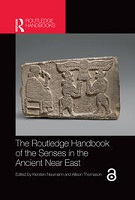Chapter 26 Language technology approach to “seeing” in Akkadian
Proposal review
Abstract
One of the ways meanings of words can be understood is based on their distributional properties. Such methodology offers an interesting quantitative viewpoint on the study of the lexicography of long-extinct languages. This chapter explores the use of Pointwise Mutual Information (PMI), a well-known statistical word association measure used in collocation analysis. PMI is applied to the data in order to gain insights on the semantic nuances of Akkadian verbs of seeing (amāru, naṭālu, palāsu, dagālu, ḫiātu, barû, and subbû). To evaluate the data-driven results, the findings are compared to previous philological work by Ainsley Dicks. The analysis of the top-ranked PMI-extracted collocates provides a good overview of the typical semantic differences between the seven verbs of interest.
Keywords
senses in the near east, senses in the ane, sensory experience in the near east, senses in mesopotamia, sensory studies in the near east, sensory studies and ancient urbanism, dress and the senses in the near east, the body and sensory studies in the near east, sensory studies and ancient dress, sensory studies and the ancient body, ritual and the senses in the near east, death and sensory studies in the near east, ritual and sensory studies in the near east, ritual and the senses in antiquity, death and the senses in antiquity, emotions and cognition in the near east, sensory studies and cognition, sensory studies and language in the near east, sound in the near eastDOI
10.4324/ 9780429280207-33ISBN
9780367235284, 9781032065663, 9780429280207Publisher
Taylor & FrancisPublisher website
https://taylorandfrancis.com/Publication date and place
2022Imprint
RoutledgeClassification
Ancient history


 Download
Download